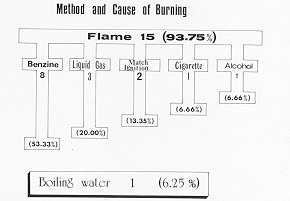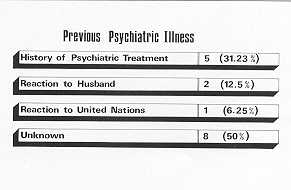Annals of the MBC - vol. 2 - n' 1 -
March 1989
SUICIDE ATTEMPTED BY BURNING
Haberal M., Oner 1, GOlay K, Bayraktar U., Bilgin N.
Hacettepe University Hospital Burn Center-Turkish
Transplantation and Burn Foundation Hospital, Ankara, Turkey.
SUMMARY. Sixteen patients who had
attempted suicide by burning were admitted to Hacettepe Univerity Hospital Burn Center
over the 9 years' period. Five of these patients were psychiatric and two of them had
previously attempted to commit suicide. The mean age was 32 years and th4 overall
mortality rate was 50%. This study shows that suicide by self-burning is giving a serious
problem with high mortality rate. Therefore, prevention and education are involved in this
matter.
Introduction
Suicides are increasing steadily,
mainly due to psycho-social problems. Of all forms of self-harm, burning by fire is
perhaps the most dramatic, rare and potentially fatal, and it needs to be distinguished in
its clinical and psycho-social aspects from other forms of self-harm. To outline the
features and outcome in this group of patients, a 9 years' retrospective study was carried
out on the patients admitted to our Bum Centre, following suicide attempts by burning.
Materials and Methods
The records of all patients admitted
to the Unit with self-burning as a method of attempting suicide over the period 1979-1988
inclusive were reviewed and within, the framework of this study, the following data were
obtained: age, sex, the method of burn injury, past history of psychiatric illness.
Previous attempted suicide, the size of bum and death in hospital were recorded.
From~ January 1, 1979 to January 1, 1988, 811 patients were admitted to our Bum Centre.
Sixteen (1.97 %) of them had attempted suicide. Of these, ten were males, and six were
females, with mean age 32 years (18 to 58 years). The cause of burn was flame in 15
patients (93.75 %) and boiling water in one patient (6.25%).
Analysis of the 15 flame burns was as follows: eight patients used petrol, three patients
used liquid gas, one used alcohol, one used cigarettes, and two used matches (Table 1).
The body surface area burnt ranged from 15 per cent to 96 per cent with a mean area of
54.50 per cent.
Previous psychiatric illness was found in five of the patients (31.25%) and two of these
had previously attempted suicide. Two patients attempted to commit suicide due to reaction
to their husbands. Another man who is a refugee attempted to bum himself in order to
contest the United Nations. In eight patients, we cannot find any specific reason for
their attempt to commit suicide (Table II).
The information was obtained directly from the patients in four cases and from relatives
in the other four.
 |
 |
| Table I |
Table II |
|
Results
16 burn patients were admitted to our
Burn Units as a result of self-inflicted burns in a 9 years' period of time; they
represented 1.97% of the total number of 811 admissions to our burn units. Most of them
were males (10); 31.25% were previously psychiatric.
Following the hospitalization, all the patients were treated with routine protocol (1)
but, unfortunately, 50% died in spite of our close monitoring and follow-up.
Discussion
Suicide attempted by self-burning is
uncommon and perhaps the most dramatic form of self-harm. Self-burning has been reported
rarely (1%) both in the UK (2) and in the USA (3). However, it is relatively common (77
per cent) as a method of suicide in Israel (4).
In our series, it occurred as 1.97% of admissions at our Centre over a 9-year-period and
we found a male preponderance (10 cases).
Ashton, Dorman et al. (5), in their series, found a history of psychiatric or personality
disorder in all but one of 36 patients. In our series, previous psychiatric illness was
found in five out of 16 patients (31.25%) and two of these had previously attempted
suicide. One suicide was attempted by burning which occurred in a protest against the
United Nations.
In a study (6), the mortality rates were analysed and found to be 48%. In our study, the
overall mortality rate was 50%. We also had anticipated a high mortality, due to longer
delay before receiving first aid, associated injury, greater surface and depth of burn, or
adverse psychological factors.
This serious problem must be regarded as a preventable tragedy and all attempts must be
directed to prevention, by recognition of at-risk patients with psychiatric illness or a
history of attempted suicide. Provision of psychiatric social support for at-risk patients
may be very important to prevent this tragic event.
RÉSUMÉ. Pendant une période de 9 ans, 16
patients qui avaient tenté de se suicider ont été hospitalisés dans le Centre des
Brûlés de l'Hôpital Universitaire Hacettepe. Cinq de ces patients étaient des cas
psychiatriques et deux d'entre eux avaient déjà attenté à leurs jours. L'âge moyen
était de 32 ans et le taux complessif de mortalité était 50 pour cent. Cette étude
indique que le suicide par brûlure est un grave problème avec un taux de mortalité
élevé. Il faut donc à l'égard un travail de prévention et d'éducation.
BIBLIOGRAPHY
- Haberal M., Oner Z., Bayraktar N., Bilgin N.:
Epidemiology of adults' and children's bums in a Turkish Burn Center. Bums, 13: 136-140,
1987.
- Ashton J.R., Dorman S.: Suicide by burning as an
epidemic phenomenon: an analysis of 82 deaths and inquests in England and Wales in 1978-9.
Psychol. Med., 11: 735, 1981.
- Andreasen N.C., Noyes R.: Suicide attempted by
self-immolation. Am. J. Psychiatry, 132: 554, 1975.
- Modan B., Nissenkom I., Lewkowski S.R.: Comparative
epidemiological aspects of suicide and attempted suicide in Israel. Am. J. Epidemiology,
91: 383, 1970.
- Ashton J.R., Dorman S.: Suicide by burning: a
current epidemic. Br. Med. J.: 2: 769, 1979.
- Davidson T.I., Brown L.C.: Self-inflicted bums: a 5
year retrospective study. Bums, 11: 157-160, 1985.
|

